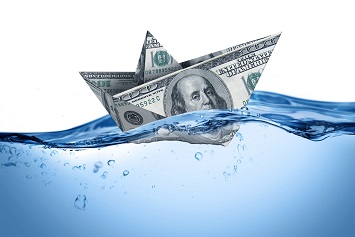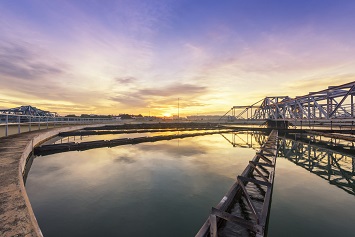Drinking water and wastewater infrastructure projects are beginning to receive loans under the federal government’s 2014 Water Infrastructure Finance and Innovation Act (WIFIA), and we can expect to see additional lending in the coming year. We describe here the background and composition of WIFIA and which types of proposals appear to be receiving interest from the EPA, which administers the WIFIA program.

A Nationwide Concern
WIFIA established a 5-year federal credit assistance program to accelerate investment in water and wastewater infrastructure of national and regional significance by offering creditworthy borrowers secured (direct) loans for up to 49 percent of the cost of eligible projects. The nationwide need to improve aging drinking water and wastewater infrastructure is nearing crisis dimensions. The EPA estimates that currently, over $743 billion is needed for improvements. This estimate is low, according to the American Water Works Association (AWWA), which believes the minimum price tag for upgrades over the next 25 years is $1 trillion; other estimates are much higher.
“While some analysts and stakeholders debate whether these estimates understate or overstate capital needs, most agree that the affected communities face formidable challenges in providing adequate and reliable water infrastructure services,” notes the Congressional Research Service (https://fas.org/sgp/crs/misc/R43315.pdf).
Eligibility Criteria
Eligible applicants for a WIFIA loan may be a corporation; partnership; joint venture; trust; federal, state, or local government entity, agency, or instrumentality; tribal government or consortium of tribal governments; or a Clean Water Act (CWA) or Safe Drinking Water Act (SDWA) State Revolving Fund (SRF) program. Eligible projects carried out by private entities must be publicly sponsored.
To be considered, prospective borrowers submit a letter of interest (LOI) that demonstrates their projects’ eligibility, financial creditworthiness, and engineering feasibility. The applicant must also show that the project meets one or several WIFIA goals. A project should enhance energy efficiency in the operation of a public water system or a publicly owned treatment works; repair, rehabilitate, or replace a treatment works, community water system, or aging water distribution or waste collection facility; provide an alternative water supply by desalination of brackish or sea water; reduce aquifer depletion; prevent, reduce, or mitigate the effects of drought; or acquire real property that would mitigate the environmental impacts of water resources infrastructure projects otherwise eligible for WIFIA assistance. Former EPA Administrator Scott Pruitt added projects that abate lead in drinking water as a WIFIA priority. Project costs must generally be $20 million or larger to be eligible for credit assistance. In rural areas (populations of 25,000 or less), project costs must be $5 million or more.
The applicant must demonstrate that it can repay credit assistance using dedicated revenue sources, which the WIFIA program defines as “such levies as taxes, rate revenue, transfers pledged from state or local governments, dedicated taxes, a municipal general obligation pledge, revenues that are pledged for the purpose of retiring debt on the project, and general recourse corporate undertakings.”
Patient Investor
WIFIA loans have benefits that are not readily available in the capital markets. Loan repayment does not need to begin until 5 years after substantial completion of a project, and the loan can be for up to 35 years from substantial completion.
“The WIFIA program can act as a patient investor and offer credit assistance with extended maturities due to the federal government’s long-term investment horizon,” says the EPA. “It can offer borrowers the advantage of developing customized terms, including sculpted repayment terms to match the specific needs of a project. Finally, the WIFIA program lends at a low, fixed interest rate equal to the Treasury rate for a comparable maturity.”
LOIs
In January 2017, the Agency invited eligible parties to submit LOIs. The Agency received 43 LOIs from prospective borrowers who requested $6 billion in WIFIA loans. Under WIFIA, the EPA evaluates and selects projects and then invites the prospective borrowers to provide the Agency with materials necessary to underwrite the proposed WIFIA assistance and to develop, through negotiation, individual credit agreements between the applicant and the Agency. In July 2017, the EPA announced that 12 projects were selected to continue with the process of applying for the approximately $2.3 billion in loans the Agency could offer. The EPA reports that as of August 16, 2018, four projects have received over $1 billion in WIFIA credit assistance. Many additional projects are under consideration. For 2018, the Agency received 62 LOIs from prospective borrowers requesting $9.1 billion; the EPA has $5.5 billion available for loans in 2018.
Implementation
Congress has provided the EPA with substantial funding to implement the WIFIA program—$175 million over 5 years. The Agency uses these funds to hire specialists to help assess applications and also to provide guidance on WIFIA’s many financing details. Prospective applicants and other interested parties should review the EPA’s WIFIA website for general information about the program and consult the Agency’s WIFIA Program Handbook for more specific guidance.
The Agency’s answers to several frequently asked questions can help potential applicants determine if they may be candidates for the next round of WIFIA loans in early 2019.
- Municipal governments can come together and apply for WIFIA funding under one application with a common security pledge.
- An eligible project can include both water and wastewater infrastructure. When including more than one discrete construction project in a combined project, each project should serve a common purpose and have similar construction time frames. Again, the loan must be secured by a common security pledge.
- There is no specific maximum dollar value for each loan. However, the EPA is limited in the total amount of credit assistance it can provide through the appropriation. Also, the Agency must set aside a portion of its appropriations for each loan to cover anticipated losses.
- Projects can receive funding under both WIFIA and CWA and SDWA SRFs. WIFIA could provide up to 49 percent of the financing, and the state SRF could provide financing for all the remaining 51 percent of eligible project costs. The EPA says it will work closely with states to help coordinate joint funding.
- Generally, the EPA expects projects to be completed within 7 years of closing. However, there is no specific maximum project length. Disbursement schedules are negotiated before the closing of a loan.
- The interest rate will be equal to or greater than the yield on U.S. Treasury securities of comparable maturity on the date of execution of the credit agreement. The base interest rate can be identified with the daily rate tables published by the Bureau of the Fiscal Service for the State and Local Government Series (SLGS) investments.
- The interest is locked at loan closing and the execution of the credit agreement.
- Repayment can be deferred for up to 5 years. Beyond that, the EPA has the flexibility to structure repayment to best match the cash flow of the project. The Agency and prospective borrowers will negotiate the repayment schedule for each project, and it will be included in the credit agreement.
Four Recipient Projects
The following four projects have received over $1 billion in WIFIA credit assistance.
Saddle Creek Retention Treatment Basin (RTB), Omaha, Nebraska
Project goal: Construct a new retention treatment basin to address combined sewer overflows (CSOs) in the Saddle Creek Basin.
The project, which will be constructed in Omaha, will provide treatment of CSOs from a 3,550-acre drainage area before release into Little Papillion Creek, which ultimately discharges to the Missouri River. The RTB will be an underground structure where combined sewage is held during wet-weather events and treated in settling tanks for removal of solids or through disinfection and dechlorination before being discharged to Little Papillion Creek. Following the wet-weather event, the contents of the RTB not discharged to Little Papillion Creek will be pumped into the existing sanitary sewer system for conveyance to the Papillion Creek Wastewater Treatment Plant, where they will receive further treatment. Aboveground improvements include a building to house controls, equipment, and chemicals and a pump station building housing dewatering pumps and associated controls.
Total project cost: $142.2 million.
Requested loan: $69.7 million.
Groundwater Replenishment System Project Final Expansion (GWRSFE) and Groundwater Replenishment System Water Conveyance Facilities Project, Orange County, California
Project goal: Expand the existing water recycling plant from 100 million gallons per day to 130 million gallons per day by using treated wastewater from the Orange County Sanitation District (OCSD) Plant 2.
The GWRSFE consists of two separate design-bid-build construction contracts. Contract 1 comprises the Advanced Water Treatment Facility (AWTF) expansion and the Orange County Sanitary District (OCSD) Plant 2 Secondary Effluent Facilities. The AWTF expansion includes microfiltration (MF), reverse osmosis (RO) treatment, and ultraviolent (UV) treatment capacity. Support facilities included in the AWFT expansion are a new MF electrical building, MF backwash waste pump, MF backwash pumps, cartridge filters, RO flush pump, decarbonated product water (DPW) pump, product water pump, surge tank, and chemical feed and storage facilities. The OCSD Plant 2 Secondary Effluent Facilities primarily comprise secondary effluent equalization tanks, a secondary effluent pump station, supporting flow structures and equipment vaults, and appurtenant facilities. Contract 2 is the Pipeline Rehabilitation Project, which includes sliplining the existing 66-inch interplant pipeline with a new 54-inch pipeline from OCSD Plant 2 to the Orange County Water District campus.
Total project cost: $282 million.
Requested loan: $135 million.
Georgetown Wet-Weather Treatment Station (GWWTS), King County, Washington
Project goal: Construct a new wet-weather treatment station (WWTS) using high-rate clarification, conveyance pipelines, and an outfall structure to treat and convey CSOs before being discharged into the Lower Duwamish Waterway.
The project comprises approximately 3,000 linear feet of new conveyance pipelines, a new regulator station, and other conveyance-system modifications to connect new and existing pipes, as well as a new outfall structure. The intent is to reduce the volume and frequency of discharges of untreated combined sewage (sanitary sewage and stormwater) to the Lower Duwamish Waterway. During wet-weather events, flows of combined sewage would be conveyed to the WWTS, where they would be screened, attenuated in an equalization basin, and then treated by ballasted sedimentation and UV disinfection. The flows of treated water would then travel through new conveyance pipelines to the new outfall structure in the Lower Duwamish Waterway.
Total project cost: $275 million.
Requested loan: $134.5 million.
Southeast Water Pollution Control Plant Biosolids Digester Facilities Project, San Francisco, California
Project goal: Replace solids treatment facilities with modern infrastructure.
The project will replace existing, outdated 60-year-old solids treatment facilities with more reliable, efficient, and modern technologies and facilities. Existing digesters will be replaced with new digesters and other new facilities that produce higher-quality biosolids; capture and treat odors more effectively; and maximize digester gas utilization and energy recovery for the production of heat, steam, and electrical power. Also, the project will locate the digesters farther away from existing residences, limit project-generated odors to the Southeast Plant fence line and make visual improvements in and around the plant.
Total project cost: $1.4 billion.
Requested loan: $699 billion.
The 12 projects the EPA selected for WIFIA credit assistance for 2017 are listed at https://www.epa.gov/wifia/wifia-selected-projects.

